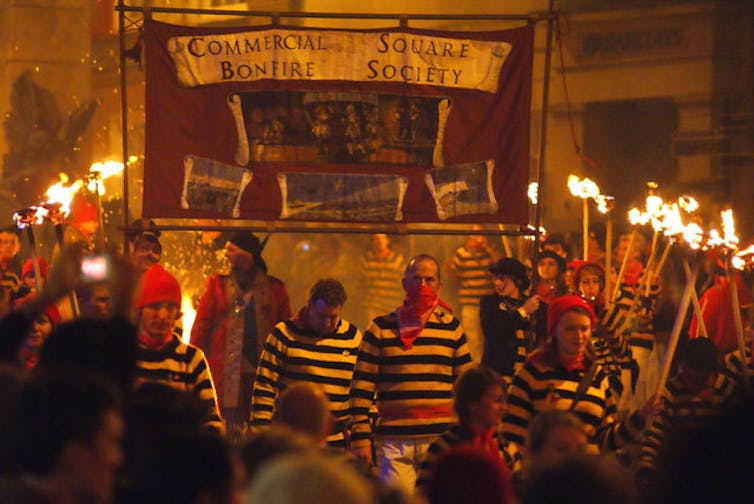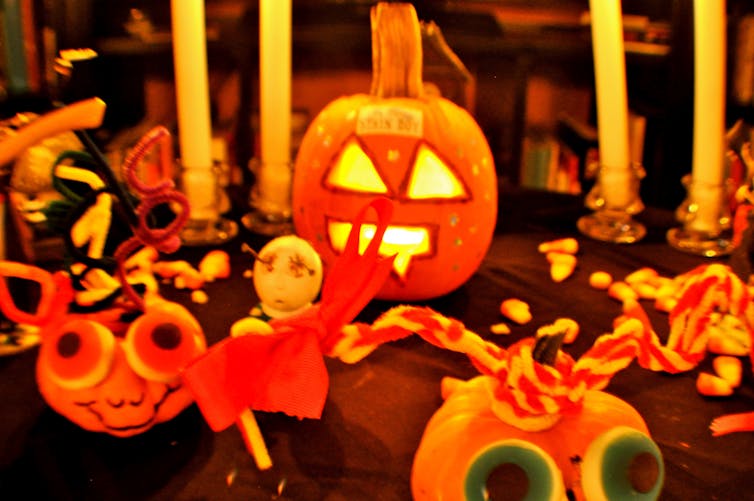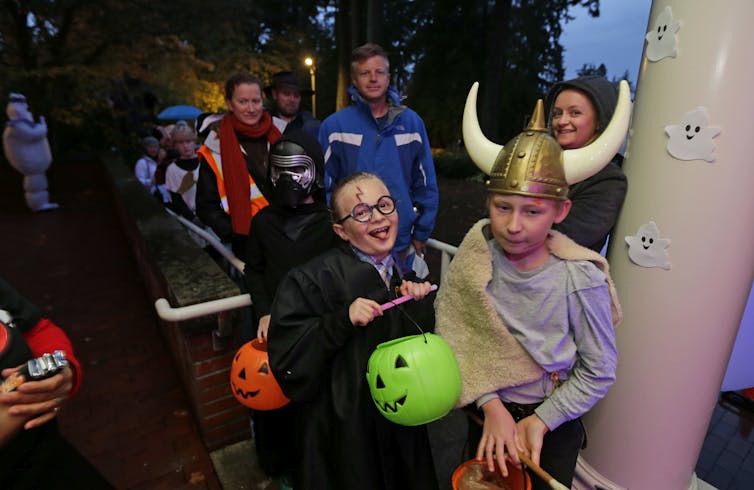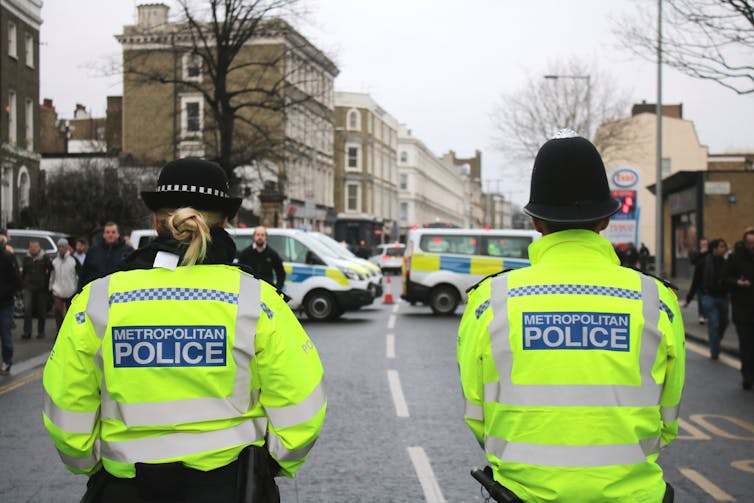Sports in Europe; Kansai Gaidai, College of Global studies, May 2020 (Online course)
Thursday, October 31, 2019
Schwingen
Another Swiss traditional sports: Hornussen
Tuesday, October 29, 2019
Article of the day: Tricking and treating has a history
Tricking and treating has a history

Over the past few decades, Halloween celebrations have gained in popularity, not only with children and families, but with all those fascinated with the spooky and scary.
As a scholar of myth and religion in popular culture, I look at Halloween with particular interest – especially the ways in which today’s Halloween tradition came to evolve.
A pre-Christian tradition
Many practices associated with Halloween have origins in the pre-Christian, or pagan, religion of the Celts, the original inhabitants of the British Isles, as well as parts of France and Spain.The Celts held a feast called Samhain – a celebration of the harvest, the end of summer and the turn of the year. Samhain was separated by six months from Beltane, an observance of the beginning of summer, which took place on May 1 and is now known as May Day. Because Samhain led into the cold, fruitless and dark days of winter, the feast was also an opportunity to contemplate death and to remember those who had gone before.
The Celts believed that the veil between the living and the dead was thinner during this time, and that spirits of the dead could walk on Earth. Bonfires were lit to ward off the coming winter darkness, but also to sacrifice livestock and crops as offerings to the gods and spirits.
Some scholars – because of the long historical association of the Celts with the Romans – have also linked the modern observance of Halloween to the Roman festival honoring Pomona, the goddess of fruit trees. During that festival people practiced divination, which uses occult for gaining knowledge of the future.
One of the practices was similar to the modern-day Halloween tradition of bobbing for apples – a party game in which people attempt to use only their teeth to pick up apples floating in a tub or a bowl of water. Originally, it was believed that whoever could bite the apple first would get married the soonest.
Later influences
Many of the modern-day practices of Halloween and even its name were influenced by Christianity.Halloween coincides with Christian celebrations honoring the dead. In the autumn, Christians celebrate All Saints’ Day – a day to honor martyrs who died for their faith and saints. They also celebrate All Souls’ Day – a day to remember the dead and to pray for souls more generally.
The history of how these dates came to coincide is worth noting: It suggests ways in which the pagan holiday may have been absorbed into Christian observance. Starting around the seventh century A.D., Christians celebrated All Saints Day on May 13. In the mid-eighth century, however, Pope Gregory III moved All Saint’s Day from May 13 to Nov. 1, so that it coincided with the date of Samhain.
Although there is disagreement about whether the move was made purposely so as to absorb the pagan practice, the fact is that from then on Christian and pagan traditions did begin to merge. In England, for example, All Saints Day came to be known as All Hallows Day. The night before became All Hallows Eve, Hallowe’en, or Halloween, as it is now known.
Around A.D. 1000, Nov. 2 was established as All Souls Day. Throughout the Middle Ages, this three-day period was celebrated with Masses. But the Pagan tradition of appeasing the spirits of the dead remained, including the Christian – now Catholic – practice of lighting candles for the souls in Purgatory.

People still light bonfires on Oct. 31, especially those in regions where the Celts originally settled. In Ireland, bonfires are lit on Halloween. In England, the bonfire tradition has been transferred to Nov. 5. This is known as Guy Fawkes Day and commemorates the Gunpowder Plot, a thwarted attempt by Catholics, led by Guy Fawkes, to blow up the Houses of Parliament in 1605.
There are other practices that continue today. In England, for example, one of the practices on All Hallows Eve was to go door to door begging for small currant biscuits called soul cakes, which were offered in exchange for prayers. While not all scholars agree, it is part of popular belief that this practice is echoed in the modern tradition of trick-or-treating.
In Ireland, people would walk the streets carrying candles in a hollowed-out turnip, the precursor of today’s jack o’lantern, or the carved pumpkin.

When the tradition came to the US
Halloween, however, did not make its way to the United States until the 1840s, when waves of immigrants from the Celtic countries of Ireland and Scotland arrived. These immigrants brought with them their tradition of Halloween, including dancing, masquerading, fortune-telling games and – in some places – the practice of parading the neighborhood asking for treats, such as nuts and fruits and coins.By the late 19th century, some stores began offering commercially made candy for Halloween.
The North American observance of Halloween also included everything from minor pranks to some major vandalism, as well as a lot of drinking. By the early 20th century, however, many municipalities and churches attempted to curb this behavior by turning Halloween into a family celebration with children’s parties and, eventually, trick-or-treating as we know it today.
Halloween today
Today, Halloween has become a multi-million-dollar industry.Candy sales, costumes, decorations, seasonal theme parks, annual television specials and October horror movie premieres are some of the many ways North Americans spend their money on the holiday.

But Halloween has come to mean many things to many people. Roman Catholics and many mainline Protestants, for example, continue to observe All Saints’ Day for its spiritual significance. In the Catholic Church it is considered a holy day of obligation, when people are required to go to Mass. All Souls’ Day is celebrated soon after. In fact, the entire month of November is set aside as a time to pray for the dead.
On the other hand, some people reject Halloween because of its pagan origins and its perceived association with witchcraft and the devil. Others see it as too commercial or primarily for children.
Nonetheless, whether people see it as a children’s holiday, a sacred ritual, a harvest festival, a night of mischief, a sophisticated adult celebration or a way to make money, Halloween has become an integral part of North American culture.
Regina Hansen, Senior Lecturer, Rhetoric, Boston University
This article is republished from The Conversation under a Creative Commons license. Read the original article.
Medieval Folk Sports (I)
Thursday, October 24, 2019
Article of the day: No wonder fox hunting is still prevalent – the ban is designed to fail British wildlife
No wonder fox hunting is still prevalent – the ban is designed to fail British wildlife
Ash Murphy, Keele UniversityDespite overwhelming public opposition and a longstanding ban, fox hunting shows no signs of abating in the UK. The 2018 hunt season alone saw 550 reports of illegal hunting, though these figures only represent known incidents.
In 2014 it was found that 250,000 fox hunters attended Boxing Day hunts across the UK. In 2019, so far, at least 21 foxes have been killed by the hunt and 151 incidents of illegal hunting have been reported since the season began on November 1.
The Hunting Act, which prohibited hunting foxes and wild mammals with dogs, was approved by the UK’s parliament in 2003 with 362 MPs in favour and 156 against. The following year it became law. In 2017, the British people were surveyed on whether they continue to support the ban on fox hunting and the result was resounding – the highest margin ever recorded on the matter - 85% thought fox hunting should remain prohibited.
So if the ban is entering its 15th year, why is fox hunting still happening?
A legal let-down
This question is answered in the Hunting Act itself, particularly the manner in which it “outlaws” fox hunting. Article 1 states that a “person commits an offence if he hunts a wild mammal with a dog”. But the provision continues: “Unless his hunting is exempt.”Herein lies the deceit of the Hunting Act, for it lists a total of nine reasons a hunt may flout the general ban. One of the more commonly invoked exemptions maintains that it is legal to hunt foxes if they pose a danger to livestock, game, crops or fisheries. As such, fox hunting advocates would have us believe that Roald Dahl’s tale of Fantastic Mr Fox and his endeavours to outwit farmers is all too common a curse in rural communities.
This remains nothing more than a smokescreen to defy the ban. Research has shown that foxes naturally control rabbit populations that if left unchecked, would cause significant economic harm to farmers. The UK government’s Department for Environment, Food and Rural Affairs (DEFRA) also advises against controlling foxes, and instead favours strengthening protection around livestock to guard against natural predation.
Another commonly used exemption exploits a loophole around flushing foxes out to help birds of prey hunt. This has seen fox hunters disguising their true intentions by taking birds of prey along with them without ever letting them loose.
There is also the dubious practise of “manufactured” trail hunting in which hounds are supposed to follow an artificial scent trail with no animal chased or killed. In reality, hunt organisers use actual fox scent and lay routes deliberately close to where foxes are known to live, meaning they quickly become the subject of a hunt. Trail hunting is again an attempt to hide the true intentions of those that wish to continue fox hunting.
Monitoring and gathering accurate information on all this to help prosecute offenders is a dangerous task, with members of the public often exposed to insults, intimidation and threats from hunters.
The inadequate Hunting Act and the nefarious practises of hunt organisers mean fox hunting endures in England and Wales. Scotland too, offers no refuge for foxes and the Protection of Wild Mammals Act 2002 provides similar loopholes that allow hunting to continue.
Setting aside the cruelty of fox hunting, evidence from the Breeding Bird Survey suggests red fox numbers have declined by 41% since 1995. Introducing a complete hunting ban is more essential than ever to protect the UK’s foxes.
A fox-centric approach
The Hunting Act has humans as its focus by specifying how people can bend the law’s provisions to their circumstances. Despite its prevalence in much of environmental law, this human-centric idea is entirely the wrong approach. Any future legislative efforts need to place foxes, and other mammals, at the centre of legislation.Foxes must be protected for their own right, and a blanket ban on hunting, absent any exemptions, is the only way to safeguard populations. Severe penalties must also be included, to ensure that those already willing to flout the law will rethink their actions.
The likelihood of such a move materialising during this parliament is slim, however. Prime Minister Theresa May offered a free vote to repeal the Hunting Act during the 2017 election but withdrew the pledge after her disastrous election result.
It’s essential that campaigns for stronger anti-hunting laws highlight how widespread resistance to diluting the ban is. The failures of the existing ban endanger foxes and betray the wishes of a majority of the public. Any update to the Hunting Act must crack down on those who think they are above the law.
Ash Murphy, PhD Researcher, Keele University
This article is republished from The Conversation under a Creative Commons license. Read the original article.
Thursday, October 17, 2019
A modern take on jousting and love
A l'entrada del tens clar
Monday, October 14, 2019
Saturday, October 12, 2019
Article of the day: Pompeii dig unearths fighting fresco in 'gladiators' tavern'
A. Giuffrida, Pompeii dig unearths fighting fresco in 'gladiators' tavern, The Guardian (11 October 2019)
Friday, October 11, 2019
Article of the day: Racist abuse at football games is increasing, Home Office says – but the sport's race problem goes much deeper
Racist abuse at football games is increasing, Home Office says – but the sport's race problem goes much deeper
Daniel Kilvington, Leeds Beckett UniversityFootball-related hate crimes rose 47% in England and Wales during the 2018-19 season, according to Home Office statistics. The number of hate crimes reported at matches jumped from 131 to 193 in just one season, and this recent spike tops a long-running rise in reported incidents over the last seven seasons.
A rise in football racism sadly wouldn’t surprise me. When countries lurch through social and political unrest, racism and xenophobia are rarely far behind. Brexit and the changing political landscape in the US and Europe have seen debates around race, ethnicity and national belonging come to the fore.
But football is changing too. Police are more common at matches than ever before – some of the most heavily policed games feature one officer for every 50 fans. Along with the match-day stewards, fans are also arguably self-policing more than ever before.
Smartphones can capture offences which enable investigations. A reporting app launched in 2015 by Kick It Out – a campaign to end discrimination of all kinds in the sport – has allowed football fans who’ve witnessed discrimination in the stands to report it anonymously. A number of professional clubs have developed their own reporting app.
So, is racism getting worse? Or, are fans just reporting it more than ever before?

Racist abuse is moving online
Let’s place these numbers in context. Racist incidents were reported at 152 out of a total of 3,022 matches during the 2018-19 season. Incidents of racist chanting occurred in just 0.5% of all matches – a slight decrease from the previous season.Racism at games is worrying, but it could be that the Home Office’s report overlooks much more pervasive hate speech online. Less than two months into the new football season and Paul Pogba, Tammy Abraham and Marcus Rashford had all encountered racist abuse on Twitter after missing penalties.
Kick It Out reported 22,000 discriminatory online posts directed at players and teams during the European Championships in 2016. During the 2014/15 English Premier League season, approximately 134,400 discriminatory posts were aimed at players and clubs. That’s an average of 16,800 discriminatory posts every month. In both pieces of research, racism was the most common form of hate speech.
Thanks to the Home Office – which uses parliamentary questions and freedom of information requests – we know how many fans were arrested for racist and indecent chanting in the 2018-19 season. But the report offers no mention of online abuse aimed at players, fans and clubs.
While the Football Association (FA) liaises with Kick It Out to deal with racism and discrimination in football stadiums, it doesn’t involve itself with incidents on social media which are flagged by Kick It Out. The FA, Kick It Out, the Professional Footballers’ Association (PFA) and professional clubs should cooperate to challenge online abuse and develop policies to protect and support people targeted online.
Collecting timely and comprehensive evidence of online abuse will help authorities understand how serious the issue is and pressure them to act. The Home Office can help by devoting more resources to investigating online abuse as well as match-day abuse in stadiums.
The ugly side of the beautiful game
Overt forms of discrimination are easy to spot and report, but it isn’t clear that as much attention is being paid to institutional forms of racism. The structural and institutional barriers that prevent Black, Asian and Minority Ethnic (BAME) groups from enjoying football are just as pervasive.My research has explored how institutionalised barriers have excluded British Asian footballers from the professional game. Historically, the recruitment system in football has relied on “white-to-white” networks and scouts, which have traditionally visited the same leagues, clubs and tournaments to find players. This system has worked to exclude British Asian footballers, as many players compete in predominantly British Asian teams or unaffiliated spaces, such as five-a-side leagues.
As a result, British Asian role models are underrepresented. My work has also highlighted that some scouts and coaches perceive British Asian players as a “gamble”, while others simply refuse to visit predominantly British Asian clubs to find players. Islamophobia in grassroots and semi-professional football also limits opportunities for young children in certain areas of the country. Together, this system has lost football decades of talent.
Read more: British Asians and football: how the 'beautiful game' needs to change
If racism is only understood as a visible phenomenon, its decline in physical spaces such as sports stadiums will be taken as evidence that it has gone away entirely. While much abuse migrates online, the time has also come to comprehend racism as a structural problem within the institutions of football.
There is one positive – people are talking about racism more. More racism is being reported whenever it appears and we, the fans, can all play our part in making sure the beautiful game can be enjoyed by everyone.
Daniel Kilvington, Senior lecturer in Media and Cultural Studies, Leeds Beckett University
This article is republished from The Conversation under a Creative Commons license. Read the original article.
Thursday, October 10, 2019
Course landaise, recortadores and forcados
See Wikipedia contributors, 'Forcado', Wikipedia, The Free Encyclopedia, 31 January 2019, 11:18 UTC, <https://en.wikipedia.org/w/index.php?title=Forcado&oldid=881090908> [accessed 9 May 2019]
Gladiators, media ; Chariot racing
Here is an English summary:
1. The mosaic shows almost a full race, from start to full speed
2. A member of the elite or an official drops a white scarf to signal the start of the race
3. An employee moves a crank to open the doors to the horses
4. It is a a four horses chariots race
5. There are 4 teams: Blue, Green, Red, White
6. There were avid spectators and fans, and bets were very important
7. Many employees are working around the track
8. One person spreads water on the ground to avoid causing too much dust
9. Two people wait for the end of the race to give the winner his prices: a palm and a laurel wreath
10. Another one is carrying a pair of scissors to rescue drivers if they fall, by untangling them for their chariot
11. Two chariots missed turning the curve and their drivers are in danger
12. Skill and strategy were essential to get a victory
See Wikipedia contributors, 'Circus Games Mosaic', Wikipedia, The Free Encyclopedia, 15 February 2018, 01:20 UTC, <https://en.wikipedia.org/w/index.php?title=Circus_Games_Mosaic&oldid=825724118> [accessed 6 May 2018]
Labels:
chariot race,
christianity,
gladiators,
mosaic,
Roman empire,
Slides
Tuesday, October 8, 2019
Europe in Kansai: Swimming with Men
Official site: http://www.synchro-dandies.jp/
| 大阪 | シネ・リーブル梅田 | 06-6440-5930 |
日本語字幕
16:00 〜 終17:45
| 9/20(金)~10/10(木) | |
| 兵庫 | シネ・リーブル神戸 | 078-334-2126 |
日本語字幕
10:10 / 16:30 〜 終18:15
| 10/4(金)~ | |
Monday, October 7, 2019
Prime Minister Abe at Rio Olympics, and Vladimir Putin in hockey exhibition
Labels:
Ice hockey,
Japan,
Modern Olympics,
Politics,
Russia
Horror humanum est; Gladiators
Thank you: reainfo, « Horror Humanum Est ». Entretien avec S. Forichon, in : Actualités des études anciennes, ISSN format électronique : 2492.864X, 28/09/2016, https://reainfo.hypotheses.org/4855.
Saturday, October 5, 2019
Book review of the day: The Ideals of Global Sport: From Peace to Human Rights
John Soares. Review of Keys, Barbara J., ed., The Ideals of Global Sport: From Peace to Human Rights.
H-Diplo, H-Net Reviews.
October, 2019.
URL: http://www.h-net.org/reviews/showrev.php?id=54282
Quote from the review's conclusion:
URL: http://www.h-net.org/reviews/showrev.php?id=54282
Quote from the review's conclusion:
In their conclusion, Keys and Burke argue that “as commercialism, doping, corruption, and gigantism spread an ever larger pall over sport mega-events, the need for a countervailing set of moral claims that can justify and excuse the excesses grows in tandem” (p. 223). Significantly, they point out, “the paucity of evidence” that these moral “claims are grounded in fact have almost never acted as a brake on the impetus to make such claims.” They write, convincingly, that “our craving for meaning and moral value guarantees that we will continue to invest our most grandiose events with a capacity to do good that they have yet to earn.” And yet, despite many disappointments, that moral veneer “has also, fitfully and sometimes unwittingly, helped reduce some of those wrongs” (p. 224). This clear and judicious conclusion is a fitting cap to a collection of essays that so commendably describes and explains the fraught connections between “mega” sport, moral improvement, and human rights. It deserves a wide readership among historians of international relations, sport, and the impact of nongovernmental agencies.
Subscribe to:
Comments (Atom)